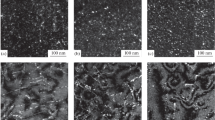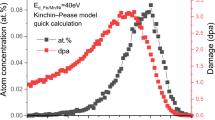Abstract
The main mechanisms of radiation embrittlement of reactor vessel materials are considered to be hardening of material as a result of the formation of matrix defects, for example, micropores and second-phase precipitates – copper and others, and a change in the cohesive strength of grain boundaries as a result of the segregation of surface-active impurities, primarily, phosphorus. The question of the degree to which the latter mechanism affects the change in the properties of reactor-vessel materials under irradiation remains open. In the present paper, computational estimates of the kinetics of radiation-stimulated segregation of phosphorus on grain boundaries in reactor-vessel materials and the resulting changes in the mechanical characteristics of steel are compared with corresponding experimental data.
Similar content being viewed by others
REFERENCES
Yu. R. Kevorkyan, Yu. A. Nikolaev, and A. V. Nikolaeva, “Effect of cascade micropores on diffusion fluxes of point defects in reactor-vessel materials,” At. Énerg., 86, No. 5, 370-383 (1999).
G. Odette, “On the dominant mechanism of irradiation embrittlement of reactor pressure vessel steels,” Scripta Metall., 17, 1183-1188 (1983).
Yu. A. Nikolaev, A. V. Nikolaeva, O. O. Zabusov, et al., “Radiation-and heat-induced adsorption of phosphorus and grain boundaries in low-alloy steel,” Fiz. Met. Metalloved., 81, No. 1, 120-128 (1996).
A. V. Nikolaeva, Yu. A. Nikolaev, and A. M. Kryukov, “Grain boundary embrittlement due to reactor pressure annealing,” J. Nucl. Mater., 211, 236-243 (1994).
Yu. A. Nikolaev and A. V. Nikolaeva, “Embrittlement of low-alloy steels due to impurity segregation and intergranular boundaries,” Material Sci. Forum, 207-209, 653-656 (1996).
L. M. Utevskii, E. É. Glikman, and G. S. Kark, Reversible Temper Brittleness of Steel and Iron Alloys,Metallurgiya, Moscow (1987).
A. V. Nikolaeva, Yu. R. Kevorkyan, and Yu. A. Nikolaev, “Comparison of observed and predicted data on radiation induced grain boundary phosphorus segregation in VVER type steels,” in: 19th International Symposium on Effects of Radiation on Materials, ASTM STP 1366, American Society for Testing and Materials, West Conshohochen, PA (2000), pp. 399-411.
Yu. I. Zvezdin,Yu. A. Nikolaev, and D. M. Shur, “Method for investigating grain-boundary phosphorus segregation in low-alloy steel and its influence on the resistance to brittle fracture,” Zavod. Lab., No. 2, 61-63 (1993).
P. L. Gruzin and V. V. Mural', “Mechanism of the influence of molybdenum on reversible temper brittleness of steel,” Metalloved. Termoobrabot., No. 3, 70-72 (1969).
P. L. Gruzin and V. V. Mural', “Influence of alloying on phosphorus diffusion in ferrite,” Fiz. Met. Metalloved., 17, 384-389 (1964).
A. V. Nikolaeva, Yu. A. Nikolaev, and Yu. R. Kevorkyan, “Grain-boundary segregation of phosphorus in low-alloy steel,” At. Énerg., 91, No. 1, 20-27 (2001).
D. McLean, Grain Boundaries in Metals [Russian translation], Metallurgizdat, Moscow (1960).
M. Miller, R. Jayaram, and K. Russell. “Characterization of phosphorus segregation in neutron-irradiated Russian pressure vessel steel weld,” J. Nucl. Mater., 225, 215-224 (1995).
M. Hashimoto, Y. Ishida, R. Yamamoto, and M. Doyama, “Atomic studies of grain boundary segregation in Fe-P and Fe-B alloy,” Acta Met., 32, No. 1, 1-11 (1984).
M. Hashimoto, Y. Ishida, R. Yamamoto, et al., “Transformation of the grain boundary structure by phosphorus segregation,” Scripta Metallurgica, 16, No. 3, 267-270 (1982).
A. Ucisik, C. McMahon, and H. Feng, “The influence of intercritical heat treatment on the temper embrittlement of rotor steels,” Met. Trans., 9A, No. 3, 321-329 (1978).
G. Spink, “Reversible temper embrittlement of rotor steels,” ibid., 8A, No. 1, 135-143 (1977).
R. Fowler and E. Guggenheim, Statistical Thermodynamics, Interscience Publishers, Cambridge (1960).
M. Guttmann, “The role of residuals and alloy elements in temper embrittlement,” Phil. Trans. Roy. Soc., 295A, 169-196 (1980).
M. Seah, “Grain boundary segregation and the T-t dependence of temper brittleness,” Acta Met., 25, No. 3, 345-357 (1977).
G. S. Kark, “Effect of phosphorus concentration in perlite steel on grain-boundary impurity maximum of the internal friction,” Trudy TsNIITmasha, No. 178, 23-34 (1983).
M. Guttmann, “The link between equilibrium segregation and the precipitation in ternary solutions exhibiting temper embrittlement,” Metal Sci, No. 10, 337-341 (1976).
A. V. Nikolaeva, Yu. A. Nikolaev, and A. M. Kryukov, “Contribution of grain boundary effects to low-alloy steel irradiation embrittlement,” J. Nucl. Mater., 218, 85-83 (1994).
A. V. Nikolaeva, Yu. R. Kevorkyan, and Yu. A. Nikolaev, “Radiation inducted grain boundary phosphorus segregation in low alloy Cr-Ni-Mo steels,” in: Proceedings of IAEA on Irradiation Embrittlement and Mitigation, IWG-LMNPP-99/2 (1999), pp. 294-405.
P. A. Platonov, V. F. Krasnoshtanov, and Yu. R. Kevorkyan, “Simulation of formation and annealing of defects in regions of damage due to collision cascades in α iron,” At. Énerg., 39, No. 4, 260-264 (1975).
M. Finnis and J. Sinclair, “A simple empirical Ni-body potential for transition metals,” Phil. Mag., 50A, No. 1, 45-55 (1984).
H. Huntington, in: Solid State Physics, Vol. 7, F. Seitz and D. Turnbull (eds.), Academic Press, NY, (1984).
G. I. Samsonov, I. F. Pryadko, and L. F. Pryadko, Configuration Model of Matter, Naukova Dumka, Kiev (1971).
B. S. Bokshtein, S. Z. Bokshtein, and A. A. Zhukhovitskii, Thermodynamics and Kinetics of Diffusion in Solids [Russian translation], Mir, Moscow (1971).
M. Oikawa, Review of Lattice Diffusion of Substitutional Impurity in Iron, A Summary Report, Technology Reports, Tohoku University (1982), Vol. 47, pp. 214-224.
R. Stoller, “Pressure vessel embrittlement predictions based on a composite model of copper precipitation and point defect clustering,” in: Effects of Radiation on the Materials, ASTM STP 1270 (1996), pp. 25-58.
E. Simonen, “Predicted irradiation effects on alloy aging kinetics,” in: Proceedings of International Conference onNuclear Power Plant, Aging, Availability Reactor and Reliability Analysis, San Diego, USA (1985), pp. 157-164.
J. Gibson, A. Goland, M. Milgram, and G. Vineyared, “Dynamics of radiation damage,” Phys. Rev., 120, No. 6, 1229-1253 (1960).
E. Mikhlin and V. Nelaev, “On the increase of the Frenkel defect recombination zone in α-iron caused by hydrostatic compression,” Phys. Stat. Solidi (a), 35, No. 1, K81-K84 (1976).
R. Jonson, “Point defect calculation for a fcc lattice,” Phys. Rev., 145, No. 2, 423-433 (1966).
K. Schroeder and K. Dettmann, “Diffusion reactions in long-range potentials,” Z. Physik B, 22, No. 2, 343-350 (1975).
T. Woite, “Theoretical treatment of the kinetics of diffusion-limited reactions,” Phys. Rev., 107, No. 2, 463-470 (1957).
D. Becher, F. Dworschak, and H. Wollenberger, “Analysis of point-defect states in copper,” Phys. Stat. Solidi (b), 54, No. 2, 455-462 (1972).
R. Lennartz, F. Dworschak, and H. Wollenberger, “Frenkel pair recombination radius in copper as a function of temperature,” J. Phys. F, 7, No. 11, 2011-2019 (1977).
J. Dural, J. Ardoncean, and J. Josset, “Endommagement du fer par irradiation aux electrons a 20 K,” J. Physique, 38, No. 8, 1007-1011 (1977).
A. M. Shalaev, Radiation-Stimulated Diffusion in Metals, Atomizdat, Moscow (1972).
V. A. Pechenkin, “On segregation on grain boundaries under irradiation of multicomponent alloys,” Preprint FÉI-2788 (1999).
D. Briggs and M. Seach (eds.), Practical Surface Analysis by Auger and x-Ray Photoelectron Spectroscopy, New York (1983).
A. V. Nikolaeva, Yu. A. Nikolaev, Yu. R. Kevorkyan, et al., “Embrittlement of low-alloy structural steel as a result of neutron irradiation,” At. Énerg., 88, No. 4, 271-276 (2000).
Yu. A. Nikolaev, A. V. Nikolaeva, A. M. Kryukov, et al., “Radiation embrittlement of VVER-1000 RPB steels,” in: Aging Materials Evaluation and Studies (AMES) Workshop on RPB Life Predictions, Madrid, Spain (November 2, 1989), pp. 35-44.
J. A. Hudson, S. G. Druce, G. Gage, and M. Wall, “Thermal aging effects in structural steels,” Theoretical and Application Fracture Mechanics, 10, 123-133 (1988).
B. A. Gurovich, A. I. Ryazanov, L. A. Elesin, et al., “Motion of dislocations in stainless during fast neutron irradiation,” ASTM STP, 570, 599-618 (1976).
Author information
Authors and Affiliations
Rights and permissions
About this article
Cite this article
Nikolaeva, A.V., Nikolaev, Y.A., Kevorkyan, Y.R. et al. Influence of Radiation-Stimulated Grain-Boundary Segregation of Phosphorus on the Operational Properties of Nuclear-Reactor-Vessel Materials. Atomic Energy 91, 884–895 (2001). https://doi.org/10.1023/A:1014257605632
Issue Date:
DOI: https://doi.org/10.1023/A:1014257605632




